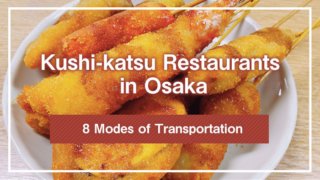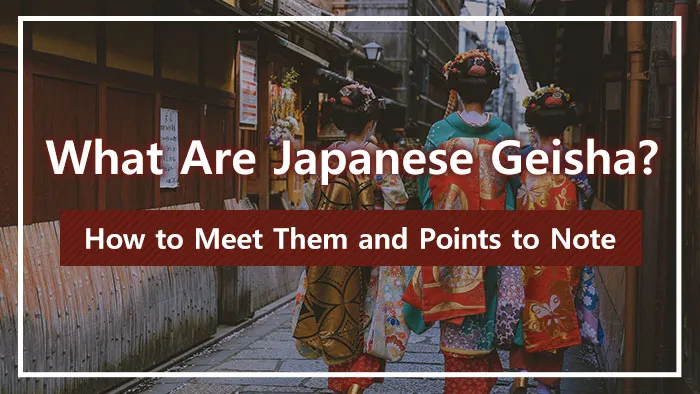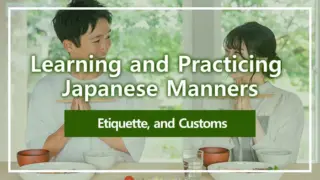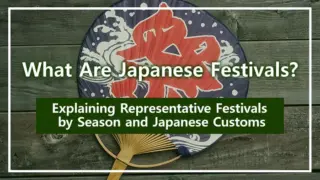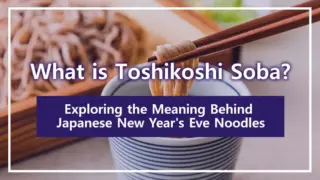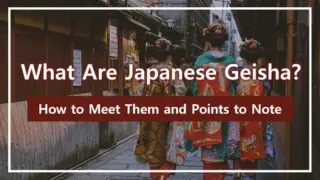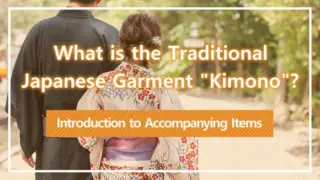Geisha have captivated people for many years as a symbol of Japanese culture. Their elegant appearance in traditional Japanese attire, entertaining guests through dance, shamisen, song, and other arts, embodies traditional beauty and courtesy. In hanamachi (geisha districts) such as those in Kyoto and Tokyo, geiko and maiko continue their daily practice, performing sophisticated arts at banquets and on stage.
This article provides detailed explanations of the work and history of geisha, the differences between maiko and geiko, and the hanamachi culture that remains today. Through the charm of geisha who continue to live within tradition, let’s explore the depth of Japanese culture.
1. What Are Japanese Geisha?
Geisha are professionals who entertain guests through traditional Japanese performing arts.They belong to hanamachi and through daily practice refine their skills in Japanese dance, nagauta (long epic songs), shamisen, song, manners, and conversation. Their primary workplace is ozashiki (banquet rooms) at restaurants and ochaya (traditional teahouses), where they elegantly enliven banquets through dance, musical performances, zashiki asobi (parlor games), and witty conversation.
They continue to appear in regional cultural events and stage performances, conveying the appeal of Japanese culture both domestically and internationally. Here, we’ll explain geisha in greater detail.
1-1. Differences Between Maiko and Geiko
In Kyoto, skilled practitioners are called geiko, while apprentices are called maiko.
Maiko are generally apprentices from their late teens, distinguished by colorful furisode (long-sleeved kimono), long hanging obi (sash), hairstyles using their own hair, thick-soled okobo (wooden clogs), and red-toned collars indicating their youth. Geiko are full-fledged arts practitioners who wear kimono in subdued colors and patterns, paired with white collars, wigs, and modest hair ornaments.
The major difference is that maiko are in the training stage, while geiko (geisha) are professionals entrusted with ozashiki duties.
1-2. The Work of Geisha
Geisha typically practice during the day and attend ozashiki from evening onward.At these gatherings, they entertain guests through dance, song, shamisen and other musical performances, conversation incorporating seasonal topics, and facilitating zashiki asobi. While they may help serve food and drink, their essence lies in hospitality centered on their arts.
Through moderate behavior and meticulous attentiveness, they set the atmosphere of the banquet, proceeding according to the host’s intentions and adapting to guests’ nationalities and ages.
1-3. History of Geisha
The origins of geisha date to the Edo period, when male entertainers called taikomochi or houkan enlivened banquets. Later, female geisha emerged and the hanamachi system became established.
In Kyoto, Gion, Pontocho, Miyagawa-cho, Kamishichiken, and Gion Higashi developed, while in Tokyo, areas like Shimbashi and Kagurazaka supported the culture. After modernization, legal reforms clarified their professional roles, and following World War II, they continued as inheritors of traditional performing arts through stage performances and regional events. Today, a culture that values rigorous training and dignity continues to be passed down.
2. Where Do Japanese Geisha Survive Today?
Geisha culture continues to thrive in cities throughout Japan. Hanamachi remain particularly in Kyoto, Tokyo, Niigata, Kanazawa, and Hakone, where each region preserves its distinctive artistic world.
Among these, Kyoto offers the most prestigious and authentic geiko culture experience. Kyoto has five hanamachi: Gion Kobu, Gion Higashi, Pontocho, Miyagawa-cho, and Kamishichiken, all traditional centers surrounded by historic streets. Geiko and maiko live in residences called okiya and practice daily. They begin training around age 15 and become full-fledged geiko after several years of training.
Tokyo also has hanamachi in Shimbashi, Kagurazaka, and Akasaka, conveying refined arts with the sophistication of Edo culture. In Kanazawa’s Higashi Chaya District, Nishi Chaya District, and Kazuemachi, geiko dance and song are cherished alongside Kaga-yuzen textile culture. The Furumachi Hanamachi in Niigata, which prospered as a port town, is also famous, with traditional arts thriving within a snow country atmosphere.
These regions offer performances and experience plans for tourists, making geisha culture more accessible.
3. Where Are Geisha Banquets Held? Who Can Attend?
Geisha banquets are primarily held at places called ochaya in hanamachi. Ochaya differ from restaurants or izakaya—rather than providing food, they are venues that rent space for banquets (ozashiki) with geisha. Meals are ordered from nearby restaurants, and the ochaya’s proprietress also arranges for geisha and maiko.
Ochaya have long had a culture valuing trust relationships, and generally first-time customers (ichigen-san) cannot enter. New customers are only accepted through introductions or guarantees from existing patrons. At ochaya, banquets are held where geisha and maiko entertain guests while enjoying food and drink together.
At ozashiki, geisha perform shamisen, song, and dance, with zashiki asobi such as “Tora Tora” (Tiger Tiger) and “Konpira Fune Fune” (Konpira Boat) conducted between performances. These are not mere entertainment but traditional Japanese culture where participants and geisha interact through words and gestures. There’s courtesy and laughter even in the games, such as losers drinking sake.
Banquets with geisha originally developed as venues for corporate entertainment and socializing among the wealthy, so not everyone can easily participate.However, regular patrons who have built trust relationships and those who receive introductions can participate individually. Formal banquets at traditional hanamachi ochaya still exist as special spaces where only select people are invited.
4. How Can Ordinary Tourists Meet Japanese Geisha?
In the past, banquets with geisha and maiko were special occasions only accessible through introduction to limited guests. However, in recent years, with growing tourism demand and changes in the industry, opportunities for ordinary travelers to experience this have expanded.
Ozashiki Experience Plans bookable through travel agencies or luxury hotels offer courses combining meals with geisha hospitality, and some plans can arrange interpreters. Applications are possible for small groups, and they are popular as special events for group tourists and foreign visitors.
For those who want to experience geisha culture more casually, performance-style experiences are also recommended. At Gion Corner in Kyoto, dances and traditional performing arts by maiko are performed nightly and can be viewed without reservations. Through such experiences, anyone can easily become familiar with traditional Japanese culture.
5. Points to Note When Encountering Geisha in Tourist Areas
【京都情報】花街・宮川町
— MKタクシー🚕 (@MKofficial_PR) March 31, 2017
祇園四条から南に下がり、少し東に入るとこの景色に出会えます。#Kyoto pic.twitter.com/EVVI4NmdhU
In tourist areas such as Kyoto and Kanazawa, you may see women in daytime wearing geisha or maiko-like attire, but most are tourists wearing geisha costumes at Maiko Transformation Studios, not real geisha. Since they are people enjoying a tourist experience, remember courtesy when asking to take photos and speak to them politely.
On the other hand, geisha and maiko seen in areas like Gion and Pontocho from evening to night are likely authentic. Since they are en route to banquets, refrain from speaking to them or photographing them. Particularly, taking photos without permission or blocking their path is a breach of etiquette. Maiko and geisha have portrait rights, and posting to social media without permission should also be avoided.
Geisha and maiko are not tourist characters but professionals preserving traditional culture. Maintaining appropriate distance, quietly seeing them off without cameras, is respectful behavior.
6. How to Distinguish Real Geisha in Tourist Areas
朝から雪のちらつく花見小路。
— 都をどり (@Miyako_Odori) February 21, 2023
インフラ工事でいったんアスファルト舗装になっていた道も、一力さん手前まで石畳に戻ってきました。 pic.twitter.com/JQakpX0ocY
To distinguish between tourists who have undergone Maiko Transformation Experiences and real geisha, first look at their hair. Real maiko style their own natural hair, but tourists mostly use wigs.
Additionally, real maiko rarely travel on foot; when heading to ozashiki, they typically travel by taxi. In other words, maiko-style women walking during the day are tourists, while those seen traveling by taxi in the evening are likely authentic.
Conclusion
Geisha are not merely tourist symbols but practitioners of Japanese culture who inherit arts and courtesy refined over long history. In hanamachi, the attitude of training as maiko and continuing to refine skills even after becoming geiko lives on.
In recent years, anyone can feel close to the world of geisha through tourist experience plans and performances. However, since geisha and maiko are also craftspeople preserving tradition as their profession, treat them with respect. We must not forget that behind the gorgeous costumes lies rigorous practice and efforts toward proud cultural inheritance.
Understanding geisha correctly and interacting with moderate behavior is the first step toward connecting Japanese tradition to the future.
*This article is based on information available as of October 2025.



